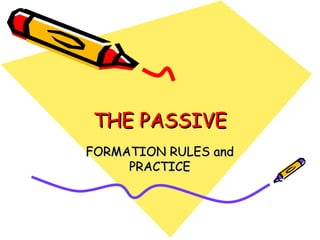Passive voice - introduction
- 1. THE PASSIVE FORMATION RULES and PRACTICE
- 2. FORMATION RULES A form of TO BE âĒ âĒ âĒ âĒ + PRESENT: am, is areâĶ PAST: was, wereâĶ FUTURE: will beâĶ PRESENT PERFECT: have beenâĶ âĒ PRESENT CONTINUOUS: is/are beingâĶ âĒ PAST CONTINUOUS: was/ were beingâĶ PAST PARTICIPLE âĒ - ED/D (regular verbs) âĒ 3rd form or irregular verbs (taken, seen, brought etc.)
- 3. Examples: New album is recorded in our studio. We will be granted a geen card. My grandma was taken to hospital. Teachers are reported for abusing students. âĒ They were seen by the principal. âĒ âĒ âĒ âĒ
- 4. âĒ Two policemenâĶ âĒ The clownâĶ
- 8. Read the sentences and decide which ones can be left without agent BY âĒ My wallet has been stolen by someone. âĒ We were taught by a different teacher yesterday. âĒ Nick was operated on at the hospital by a doctor. âĒ The meal was served by a waiter in a red coat. âĒ We were shown round the museum by a guide. âĒ Two letters were delivered this morning by the postman âĒ Yesterday a window was broken by someone.
- 9. Active sentences with 2 objects âĒ 1. 2. âĒ 1. 2. Peter gave Karen a present. Karen âĶâĶâĶâĶâĶâĶâĶa present by Peter. A presentâĶâĶâĶâĶâĶto Karen by Peter. A friend will sell me a concert ticket. IâĶâĶâĶ. A concert ticketâĶ.
- 10. Active sentences with 2 objects âĒ 1. 2. âĒ 1. 2. Peter gave Karen a present. Karen âĶâĶâĶâĶâĶâĶâĶa present by Peter. A presentâĶâĶâĶâĶâĶto Karen by Peter. A friend will sell me a concert ticket. IâĶâĶâĶ. A concert ticketâĶ.










